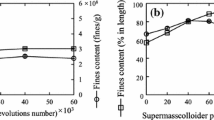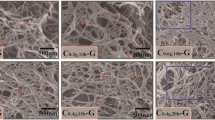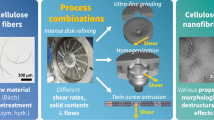Abstract
A fundamental understanding of the morphological development of cellulose fibers during fibrillation using micro grinder is very essential to develop effective strategies for process improvement and to reduce energy consumption. We demonstrated some simple measures for characterizing cellulose fibers fibrillated at different fibrillation times through the grinder. The morphology and degree of fibrillation of the samples at different stages of fibrillation were characterized. The fibrillation and mechanical properties reached a maximum in 2 h, and did not show any significant change with further grinding. The lateral dimensions of the smallest nanofibrils were between 15 and 40 nm. A slight reduction in the crystallinity and degree of polymerization did not lead to decrease in mechanical properties of cellulose films. The lower tensile properties at the initial stages of fibrillation are mainly due to the presence of limited refined and heterogeneously treated fibers.









Similar content being viewed by others
References
Abe K, Iwamoto S, Yano H (2007) Obtaining cellulose nanofibers with a uniform width of 15 nm from wood. Biomacromolecules 8(10):3276–3278
Abraham E, Deepa B, Pothan LA, Jacob M, Thomas S, Cvelbar U, Anandjiwala R (2011) Extraction of nanocellulose fibrils from lignocellulosic fibers: a novel approach. Carbohydr Polym 86(4):1468–1475
Agarwal UP, Reiner RS, Ralph SA (2010) Cellulose I crystallinity determination using FT-Raman spectroscopy: univariate and multivariate methods. Cellulose 17(4):721–733
Cheng Q, Wang SQ, Rials TG, Lee SH (2007) Physical and mechanical properties of polyvinyl alcohol and polypropylene composite materials reinforced with fibril aggregates isolated from regenerated cellulose fibers. Cellulose 14(6):593–602
Chinga-Carrasco G, Syverud K (2010) Computer-assisted quantification of the multiscale structure of films made of nanofibrillated cellulose. J Nanoparticle Res 12:841–851
Chinga-Carrasco G, Syverud K (2012) On the structure and oxygen transmission rate of biodegradable cellulose nanobarriers. Nanoscale Res Lett 7:192
Chinga-Carrasco G, Kuznetsova N, Garaeva M, Leirset I, Galiullina G, Kostochko A, Syverud K (2012) Bleached and unbleached MFC nanobarriers: properties and hydrophobisation with hexamethyldisilazane. J Nanopart Res 14:1280
Dang Z, Zhang JG, Ragauskas AJ (2007) Characterizing TEMPO-mediated oxidation of ECF bleached softwood kraft pulps. Carbohydr Polym 70(3):310–317
Dash R, Foston M, Ragauskas AJ (2013) Improving the mechanical and thermal properties of gelatin hydrogels cross linked by cellulose nanowhiskers. Carbohydr Polym 91(2):638–645
Gardner KH, Blackwell J (1974) The structure of native cellulose. Biopolymers 13:1975–2001
He L, Li X, Li W, Yuan J, Zhou H (2012) A method for determining reactive hydroxyl groups in natural fibers: application to ramie fiber and its modification. Carbohydr Res 348:95–98
Henriksson M, Berglund LA, Isaksson P, Lindstroem T, Nishino T (2008) Cellulose nanopaper structures of high toughness. Biomacromolecules 9(6):1579–1585
Hietanen S, Ebeling K (1990) A new hypothesis for the mechanics of refining. Pap Puu 72(2):172–179
Hoeger IC, Nair SS, Ragauskas AJ, Deng Y, Rojas OJ, Zhu JY (2013) Mechanical deconstruction of lignocellulose cell walls and their enzymatic saccharification. Cellulose 20(2):807–818
Iwamoto S, Nakagaito AN, Yano H (2007) Nano-fibrillation of pulp fibers for the processing of transparent nanocomposites. App Phys A Mater Sci Process 89(2):461–466
Kaushik A, Singh M (2011) Isolation and characterization of cellulose nanofibrils from wheat straw using steam explosion coupled with high shear homogenization. Carbohydr Res 346:76–85
Kerekes RJ (2005) Characterizing refining action in PFI mills. TAPPI 4(3):9–14
Kulachenko A, Denoyelle T, Galland S, Lindstroem SB (2012) Elastic properties of cellulose nanopaper. Cellulose 19(3):793–807
Liu H, Zhu JY, Chai XS (2011) In situ, rapid, and temporally resolved measurements of cellulase adsorption onto lignocellulosic substrates by UV–Vis spectrophotometry. Langmuir 27(1):272–278
Nakagaito AN, Yano H (2004) The effect of morphological changes from pulp fiber towards nano-scale fibrillated cellulose on the mechanical properties of high-strength plant fiber based composites. Appl Phys A Mater Sci Process 78(4):547–552
Nissan AH, Sternstein SS (1964) Cellulose-fiber bonding. TAPPI 47(1):1–6
Oksanen T, Pere J, Buchert J, Viikari L (1997) The effect of trichoderma reesei cellulases and hemicellulases on the paper technical properties of never-dried bleached kraft pulp. Cellulose 4:329–339
Page DH (1969) Theory for the tensile strength of paper. TAPPI 52(4):674–681
Seth RS (1999) Beating and refining response of some reinforcement pulps. TAPPI 82(3):147–155
Seth RS (2006) The importance of fiber straightness for pulp strength. Pulp Pap Can 107(1):34–41
Shinoda R, Saito T, Okita Y, Isogai A (2012) Relationship between length and degree of polymerization of tempo-oxidized cellulose nanofibrils. Biomacromolecules 13(3):842–849
Siro I, Plackett D (2010) Microfibrillated cellulose and new nanocomposite materials: a review. Cellulose 17(3):459–494
Spence KL, Venditti RA, Rojas OJ, Habibi Y, Pawlak JJ (2011) A comparative study of energy consumption and physical properties of microfibrillated cellulose produced by different processing methods. Cellulose 18(4):1097–1111
Stelte W, Sanadi AR (2009) Preparation and characterization of cellulose nanofibers from two commercial hardwood and softwood pulps. Ind Eng Chem Res 48(24):11211–11219
Syverud K, Xhanari K, Chinga-Carrasco G, Yu Y, Stenius P (2011) Films made of cellulose nanofibrils: surface modification by adsorption of a cationic surfactant and characterization by computer-assisted electron microscopy. J Nanopart Res 13:773–782
Uetani K, Yano H (2011) Nanofibrillation of wood pulp using a high-speed blender. Biomacromolecules 12(2):348–353
Wang QQ, Zhu JY, Gleisner R, Kuster TA, Baxa U, McNeil SE (2012) Morphological development of cellulose fibrils of a bleached eucalyptus pulp by mechanical fibrillation. Cellulose 19(5):1631–1643
Weise U, Maloney T, Paulapuro H (1996) Quantification of water in different states of interaction with wood pulp fibres. Cellulose 3(4):189–202
Acknowledgments
This work was partially supported by the USDA Forest Service R&D special funding on Cellulose Nano-Materials (2012).
Author information
Authors and Affiliations
Corresponding author
Rights and permissions
About this article
Cite this article
Nair, S.S., Zhu, J.Y., Deng, Y. et al. Characterization of cellulose nanofibrillation by micro grinding. J Nanopart Res 16, 2349 (2014). https://doi.org/10.1007/s11051-014-2349-7
Received:
Accepted:
Published:
DOI: https://doi.org/10.1007/s11051-014-2349-7




